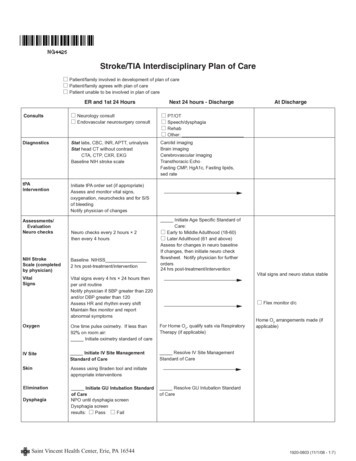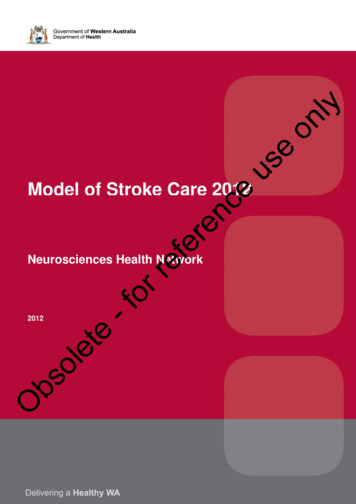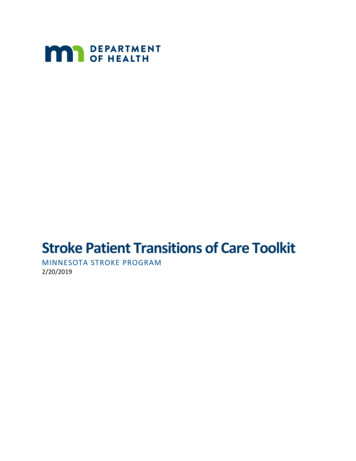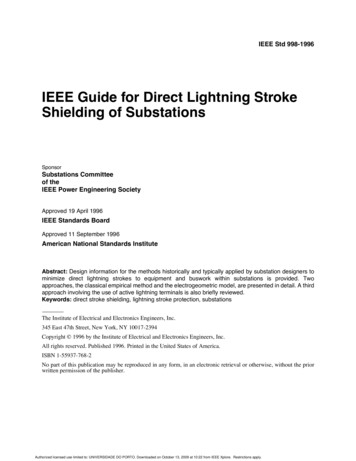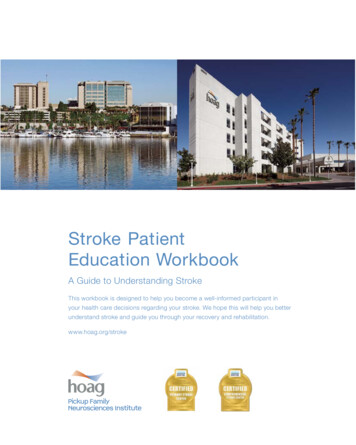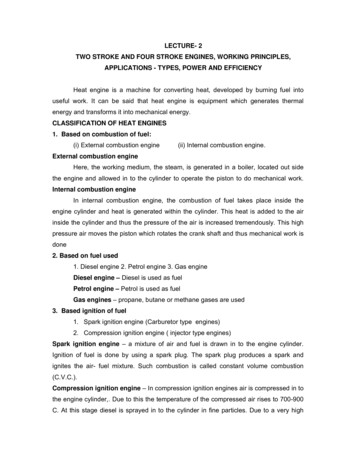
Transcription
LECTURE- 2TWO STROKE AND FOUR STROKE ENGINES, WORKING PRINCIPLES,APPLICATIONS - TYPES, POWER AND EFFICIENCYHeat engine is a machine for converting heat, developed by burning fuel intouseful work. It can be said that heat engine is equipment which generates thermalenergy and transforms it into mechanical energy.CLASSIFICATION OF HEAT ENGINES1. Based on combustion of fuel:(i) External combustion engine(ii) Internal combustion engine.External combustion engineHere, the working medium, the steam, is generated in a boiler, located out sidethe engine and allowed in to the cylinder to operate the piston to do mechanical work.Internal combustion engineIn internal combustion engine, the combustion of fuel takes place inside theengine cylinder and heat is generated within the cylinder. This heat is added to the airinside the cylinder and thus the pressure of the air is increased tremendously. This highpressure air moves the piston which rotates the crank shaft and thus mechanical work isdone2. Based on fuel used1. Diesel engine 2. Petrol engine 3. Gas engineDiesel engine – Diesel is used as fuelPetrol engine – Petrol is used as fuelGas engines – propane, butane or methane gases are used3. Based ignition of fuel1. Spark ignition engine (Carburetor type engines)2. Compression ignition engine ( injector type engines)Spark ignition engine – a mixture of air and fuel is drawn in to the engine cylinder.Ignition of fuel is done by using a spark plug. The spark plug produces a spark andignites the air- fuel mixture. Such combustion is called constant volume combustion(C.V.C.).Compression ignition engine – In compression ignition engines air is compressed in tothe engine cylinder,. Due to this the temperature of the compressed air rises to 700-900C. At this stage diesel is sprayed in to the cylinder in fine particles. Due to a very high
temperature, the fuel gets ignited. This type of combustion is called constant pressurecombustion (CP.C.) because the pressure inside the cylinder is almost constant whencombustion is taking place.4. Based on working cycle1. Four stroke cycle engine - When the cycle is completed in two revolutionsof the crankshaft, it is called four stroke cycle engine.2. Two stroke cycle engine. - When the cycle is completed in one revolution ofthe crankshaft, it is called two stroke cycle engineCONSTRUCTION OF AN IC ENGINEI.C. engine converts the reciprocating motion of piston into rotary motion of thecrankshaft by means of a connecting rod. The piston which reciprocating in the cylinderis very close fit in the cylinder. Rings are inserted in the circumferential grooves of thepiston to prevent leakage of gases from sides of the piston. Usually a cylinder is bored ina cylinder block and a gasket, made of copper sheet or asbestos is inserted between thecylinder and the cylinder head to avoid ant leakage. The combustion space is providedat the top of the cylinder head where combustion takes place. The connecting rodconnects the piston and the crankshaft. The end of the connecting rod connecting thepiston is called small end. A pin called gudgeon pin or wrist pin is provided forconnecting the piston and the connecting rod at the small end. . The other end of theconnecting rod connecting the crank shaft is called big end. When piston is moved upand down, the motion is transmitted to the crank shaft by the connecting rod and thecrank shaft makes rotary motion. The crankshaft rotates in main bearings which arefitted the crankcase. A flywheel is provided at one end of the crankshaft for smoothingthe uneven torque produced by the engine. There is an oil sump at the bottom of theengine which contains lubricating oil for lubricating different parts of the engine.WORKING PRINCIPLE OF I.C. ENGINE/ FOUR STROKE CYCLE ENGINE / TWOSTROKE CYCLE ENGINEA mixture of fuel with correct amount of air is exploded in an engine cylinderwhich is closed at one end. As a result of this explosion, heat is released and this heatcauses the pressure of the burning gases to increase. This pressure forces a close fittingpiston to move down the cylinder. The movement of piston is transmitted to a crankshaftby a connecting rod so that the crankshaft rotates and turns a flywheel connected to it.Power is taken from the rotating crank shaft to do mechanical work. To obtaincontinuous rotation of the crankshaft the explosion has to be repeated continuously.
Before the explosion to take place, the used gases are expelled from the cylinder, freshcharge of fuel and air are admitted in to the cylinder and the piston moved back to itsstarting position. The sequences of events taking place in an engine is called theworking cycle of the engine. The sequence of events taking place inside the engine areas follows1. Admission of air or air-fuel mixture inside the engine cylinder ( suction )2. Compression of the air or air fuel mixture inside the engine (compression)3. Injection of fuel in compressed air for ignition of the fuel or ignition of air-fuelmixture by an electric spark using a spark plug to produce thermal powerinside the cylinder (power )4. Removal of all the burnt gases from the cylinder to receive fresh charge (exhaust)Note: Charge means admitting fresh air in to the cylinder in the case of compressionignition engines ( diesel engines ) or admitting a mixture of air and fuel in to thecylinder in the case of spark ignition engines.FOUR STROKE CYCLE ENGINE ( DIESEL/ PETROL ENGINE)In four stroke cycle engines the four events namely suction, compression, powerand exhaust take place inside the engine cylinder. The four events are completed in fourstrokes of the piston (two revolutions of the crank shaft). This engine has got valves forcontrolling the inlet of charge and outlet of exhaust gases. The opening and closing ofthe valve is controlled by cams, fitted on camshaft. The camshaft is driven by crankshaftwith the help of suitable gears or chains. The camshaft runs at half the speed of thecrankshaft. The events taking place in I.C. engine are as follows:1. Suction stroke2. Compression stroke3. Power stroke4. Exhaust stroke
Four stroke cycle engineFour stroke cycle engineSuction strokeDuring suction stroke inlet valve opens and the piston moves downward. Only airor a mixture of air and fuel are drawn inside the cylinder. The exhaust valve remains inclosed position during this stroke. The pressure in the engine cylinder is less thanatmospheric pressure during this stroke (Fig. 1a)
Compression strokeDuring this stroke the piston moves upward. Both valves are in closed position.The charge taken in the cylinder is compressed by the upward movement of piston. Ifonly air is compressed, as in case of diesel engine, diesel is injected at the end of thecompression stroke and ignition of fuel takes place due to high pressure andtemperature of the compressed air. If a mixture of air and fuel is compressed in thecylinder, as in case of petrol engine, the mixture is ignited by a spark plug.Power strokeAfter ignition of fuel, tremendous amount of heat is generated, causing very highpressure in the cylinder which pushes the piston downward (Fig.1b). The downwardmovement of the piston at this instant is called power stroke. The connecting rodtransmits the power from piston to the crank shaft and crank shaft rotates. Mechanicalwork can be taped at the rotating crank shaft. Both valves remain closed during powerstroke.Exhaust strokeDuring this stroke piston moves upward. Exhaust valve opens and exhaust gasesgo out through exhaust valves opening. All the burnt gases go out of the engine and thecylinder becomes ready to receive the fresh charge. During this stroke inlet valveremains closed (Fig.1d).Thus it is found that out of four strokes, there is only one power stroke and threeidle strokes in four stroke cycle engine. The power stroke supplies necessarymomentum for useful work.TWO STROKE CYCLE ENGINE (PETROL ENGINE)In two stroke cycle engines, the whole sequence of events i.e., suction,compression, power and exhaust are completed in two strokes of the piston i.e. onerevolution of the crankshaft. There is no valve in this type of engine. Gas movementtakes place through holes called ports in the cylinder. The crankcase of the engine is airtight in which the crankshaft rotates.
Two stroke cycleUpward stroke of the piston (Suction Compression)When the piston moves upward it covers two of the ports, the exhaust port andtransfer port, which are normally almost opposite to each other. This traps the charge ofair- fuel mixture drawn already in to the cylinder. Further upward movement of the pistoncompresses the charge and also uncovers the suction port. Now fresh mixture is drawnthrough this port into the crankcase. Just before the end of this stroke, the mixture in the
cylinder is ignited by a spark plug (Fig 2 c &d). Thus, during this stroke both suction andcompression events are completed.Downward stroke (Power Exhaust)Burning of the fuel rises the temperature and pressure of the gases which forcesthe piston to move down the cylinder. When the piston moves down, it closes the suctionport, trapping the fresh charge drawn into the crankcase during the previous upwardstroke. Further downward movement of the piston uncovers first the exhaust port andthen the transfer port. Now fresh charge in the crankcase moves in to the cylinderthrough the transfer port driving out the burnt gases through the exhaust port. Specialshaped piston crown deflect the incoming mixture up around the cylinder so that it canhelp in driving out the exhaust gases . During the downward stroke of the piston powerand exhaust events are completed.COMPARISON BETWEEN TWO STROKE AND FOUR STROKE ENGINESFour stroke engine1. OnepowerstrokeTwo stroke engineforeverytwo One power stroke for each revolution ofrevolutions of the crankshaft.the crankshaft.2. There are inlet and exhaust valves in There are inlet and exhaust ports insteadthe engine.3. Crankcase is not fully closed and airtight.of valves.Crankcase is fully closed and air tight.4. Top of the piston compresses the Both sides of the piston compress thecharge.charge.5. Size of the flywheel is comparatively Size of the flywheel is comparativelylarger.6. Fuel is fully consumed.7. Weight of engine per hp is high.8. Thermal efficiency is high.9. Removal or exhaust gases easy.10. Torque produced is even.smaller.Fuel is not fully consumed.Weight of engine per hp is comparativelylow.Thermal efficiency is comparatively low.Removal of exhaust gases comparativelydifficult.Torque produced is less even.11. For a given weight, engine would give For same weight, two stroke engine givesonly half the power of two stroke twice the power that of four stroke engine.
engine.12. All types of speed are possible (highand low).Mostly high speed engines are there.13. It can be operated in one direction It can be operated in both directiononly.(clockwise and counter clockwise).WORKING PRINCIPLE OF DIESEL ENGINEThe basic components of diesel engine are cylinder, piston, injector, valves,connecting rod and crankshaft. In diesel engines only air is drawn into the cylinder. Theengine has high compression ratio hence the air in the cylinder attains very hightemperature and pressure at the end of the compression stroke. At the end of thecompression stroke, the fuel is sprayed into the cylinder in atomized form using injectors.Due to high temperature, the fuel gets ignited, begins to burn and produce lot of heat.Due to the heat the gases expand, move the piston downward and rotate the crankshaft. The torque available at the rotating crank shaft is used to do any mechanical workSpecial features of diesel engine1) Engine has high compression ratio ranging from 14:1 to 22:1.2) During compression stroke, the engine attains high pressure ranging from 30 to 45kg/cm2 and high temperature of about 500 C.3) At the end of the compression stroke, fuel is injected into the cylinder throughinjectors (atomizers) at a very high pressure ranging from 120 to 200 kg/cm2.4) Ignition takes place due to heat of compression only.5) There is no external spark in diesel engine.6) Diesel engine has better slogging or lugging ability i.e. it maintains higher torque fora longer duration of time at a lower speed.COMPARISON OF DIESEL ENGINE WITH PETROL ENGINEDiesel enginei)petrol engineIt has got no carburetor, ignition coil and It has got carburetor, ignition coil & sparkspark plug.plug.ii) Its compression ratio varies from 14:1 to Its compression ratio varies from 5:1 to22:1iii) It uses diesel oil as fuel.8:1.It uses petrol (gasoline) or power kerosineas fuel.
iv) Only air is sucked in cylinder in suction Mixture of fuel and air is sucked in thestroke.cylinder in suction stroke.v) It has got ‘fuel injection pump’ andinjectorIt has got no fuel injection pump andinjector, instead it has got carburetor andignition coil.vi) Fuel is injected in combustion chamber Air fuel mixture is compressed in thewhere burning of fuel takes places due combustion chamber when it is ignited byto heat of compression.an electric spark.vii) Thermal efficiency varies from 32 to38%viii) Engine weight per horse-power is high.ix) Operating cost is low.x) CompressionpressureThermal efficiency varies from 25 to 32%Engineweightperhorsepoweriscomparatively low.Operating cost is high.insidethe2cylinder varies from 35 to 45 kg/cm andtemperature is about 500 C.Compression pressure varies from 6 to 10kg/cm2 and temperature is above 260 C.ENGINE COMPONENTSInternal combustion engine consists of a number of parts which are given below :i) Cylinder: It is a part of the engine which confines the expanding gases and forms thecombustion space. It is the basic part of the engine. It provides space in which pistonoperates to suck the air or air-fuel mixture. The piston compresses the charge and thegas is allowed to expand in the cylinder, transmitting power for useful work. Cylindersare usually made of high grade cast iron.ii) Cylinder block:
Heat engine is a machine for converting heat, developed by burning fuel into useful work. It can be said that heat engine is equipment which generates thermal energy and transforms it into mechanical energy. CLASSIFICATION OF HEAT ENGINES 1. Based on combustion of fuel: (i) External combustion engine (ii) Internal combustion engine. External combustion engine Here, the working medium, the .File Size: 342KBPage Count: 15






